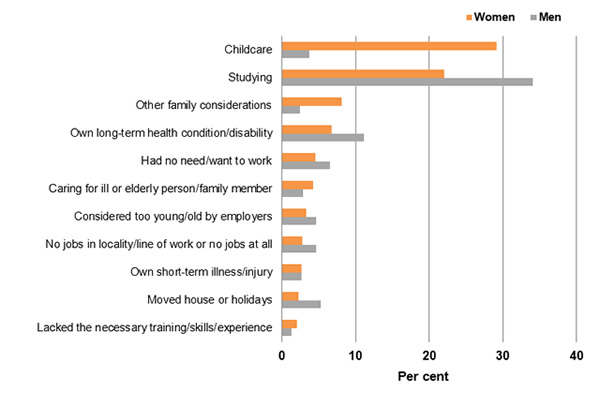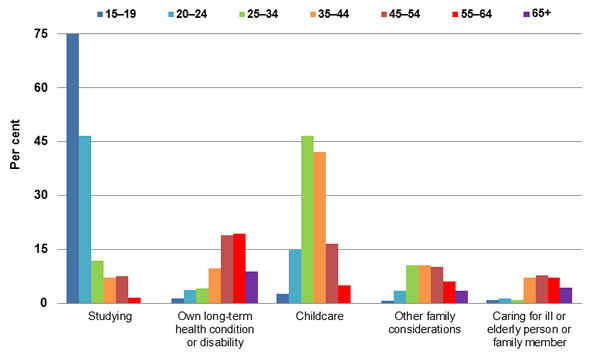Posted 29/11/2017 by Penny Vandenbroek
The Australian Bureau of Statistics (ABS) has released the 2017 results from their survey of Participation, job search and mobility. This survey data provides information on job seekers and job switchers, as well as people who are not in the labour force; that is, those who are not working, nor looking for work. Within this group of people, there are various reasons as to why people do not need or want a job. The main reasons people are not in the labour force is the focus of this article.
Not in the labour force
To be part of the labour force a person needs to be either employed (i.e. working, generally for some type of remuneration) or unemployed. To be classified as unemployed, a person has to be actively seeking work and available to start work within a defined period. Actively seeking work includes such things as applying for jobs or having an interview with a prospective employer. The steps taken are considered more substantial than a general declaration of looking for work. People who are not working and do not meet the definition of unemployed are considered to be outside of the labour force.
Main reason for not actively seeking work
Unless a person is permanently unable, or not intending, to work, the ABS asks whether they would like a job. If a person indicates they would like to work, or might like to work, they are asked about their availability to accept and commence a job. From a list of reasons, people are asked to select any reason that has impacted on their ability to look for work. The reasons include: study commitments; illness or injury (either short or long-term); care responsibilities (children, the elderly or infirm); and perceptions about the availability or suitability of potential work. From the selected reasons, people are then asked to select their main reason. It is this reason that is explored below. Note that people whose main reason was ‘they had a job to go to’ have been excluded from the calculations.
The main reason a person did not actively seek work varies by sex. Figure 1 provides selected main reasons why men and women were not in the labour force, at February 2017. The largest difference between men and women was childcare responsibilities, with 29% of women citing this as their main reason, compared with 4% of men. The second most common reason women were not actively seeking work was study commitments (22%). Women were also more likely than men to cite ‘Other family considerations’, as well as ‘Caring for an ill or elderly person or family member’. For men, the top reason was that they were studying (35%), followed by their own long-term health condition or disability (11%). Men were more than twice as likely as women to say they had moved house or were on holidays.
1. Selected main reasons for not actively seeking work, by sex, February 2017

Source: Participation, job search and mobility, Feb 2017, cat. no. 6226.0 (Customised table)
The main reason a person did not actively seek work also varies by age. In February 2017, studying (attending an educational institution, returning to study) was the top reason for young people (15 to 19 and 20 to 24 years). Child care was the top reason for people in age groups 25 to 34 years and 35 to 44 years. A long-term health condition or disability was more likely to impact on someone’s ability to seek work as age increased, with this being the main reason for people aged 45 to 54 years and 55 to 64 years. While not shown in the chart, people in the two uppermost age groups were the most likely to say they didn’t need or want a job—11% of people aged 55 to 64 years and 17% of those aged 65 years and over. Figure 2 provides selected main reasons why people weren’t looking for work by age groups, at February 2017.
2. Selected main reasons for not actively seeking work, by age, February 2017

Source: Participation, job search and mobility, Feb 2017, cat. no. 6226.0 (Customised table)
Analysing why people aren’t seeking work by age helps to understand life-course related reasons for non-labour force participation. Analysis incorporating other characteristics, such as social marital status, post-school qualifications, relationship status in household or area of usual residence, can also be useful.
These groups of potential jobseekers are a sub-set of those who are not in the labour force. They are people who wanted to work, were available to work within a four week period, but were not actively seeking work due to specific reasons.
The ‘Participation potential’ summary published by the ABS provides related information on people’s main activity when they are not in the labour force, as well as discouraged job seekers. For questions or further assistance please contact the Parliamentary Library Statistics and Mapping Section.